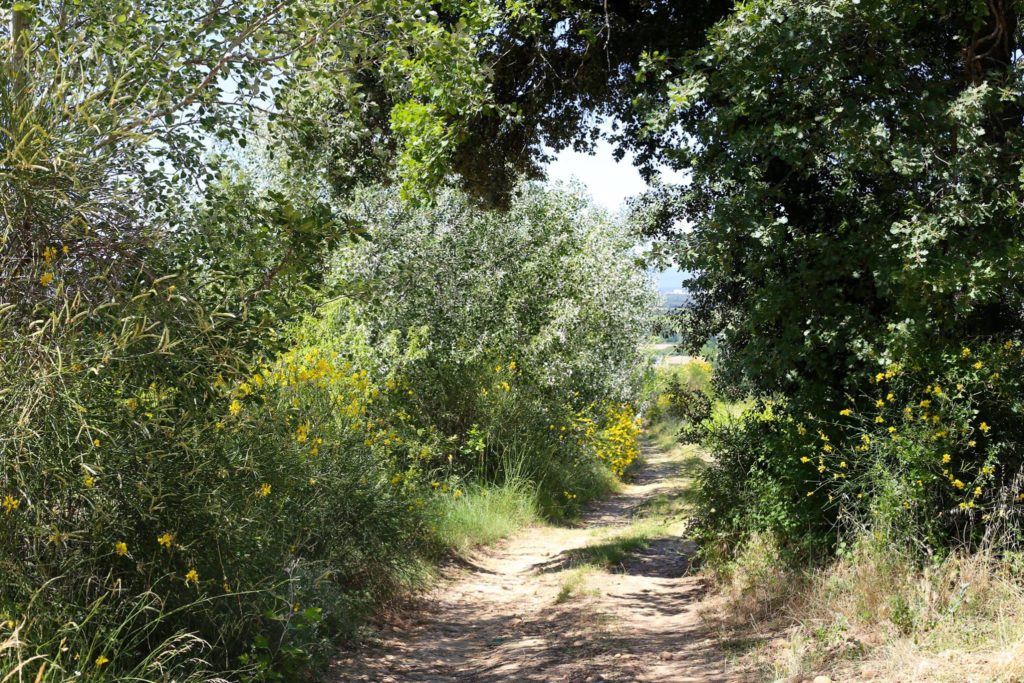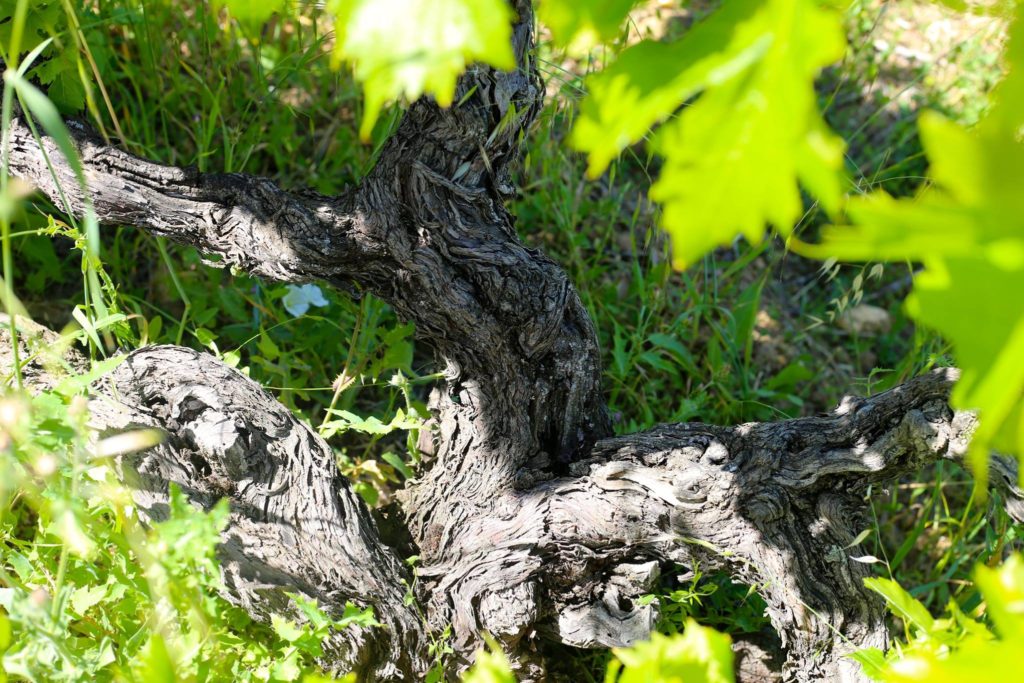Jean-Paul Daumen talks about winemaking
– Visit of the cellar- (Japanese/ English)
ジャン=ポール・ドーメンがワイン作りについて語る

貯蔵室にて
ここでは、温度調整システムをタンクの下に備えています。
発酵時、コンクリートタンクの温度をできる限りゆっくり下げ、適切な温度に保つためです。
醸造の過程において、まずは貯蔵室を涼しい状態に整えること、また夏の間も室温は18〜19℃で保つようにしています。
収穫の1ヶ月前には室温を15℃まで下げておくことでタンク自体も15℃に冷え、その後の醸造を涼しい中冷えたタンクで進めていくことができます。
収穫時のリスクの一つに、気温が高いことがあげられます。
2016年は問題なかったのですが、年によっては、貯蔵室にブドウを運んだ際28〜29℃近くまでになることもあり、そのような場合は涼しい環境がまさに必要になってきます。
私たちは、暑かろうが寒かろうが、ブドウそのものに手を施すということはありません。
むしろブドウの環境にのみ介入することで、ブドウに寄り添っているという考えなのです。
発酵の終盤、室温をわずかに上げることによりタンク内の温度がゆっくり下がるようにします。
先程お話した室温を冷やしておくことにより、外の高い温度にでも対応できるようにするなど
ブドウには直接的に介入せず、環境に寄り添いながら醸造過程を進めています。

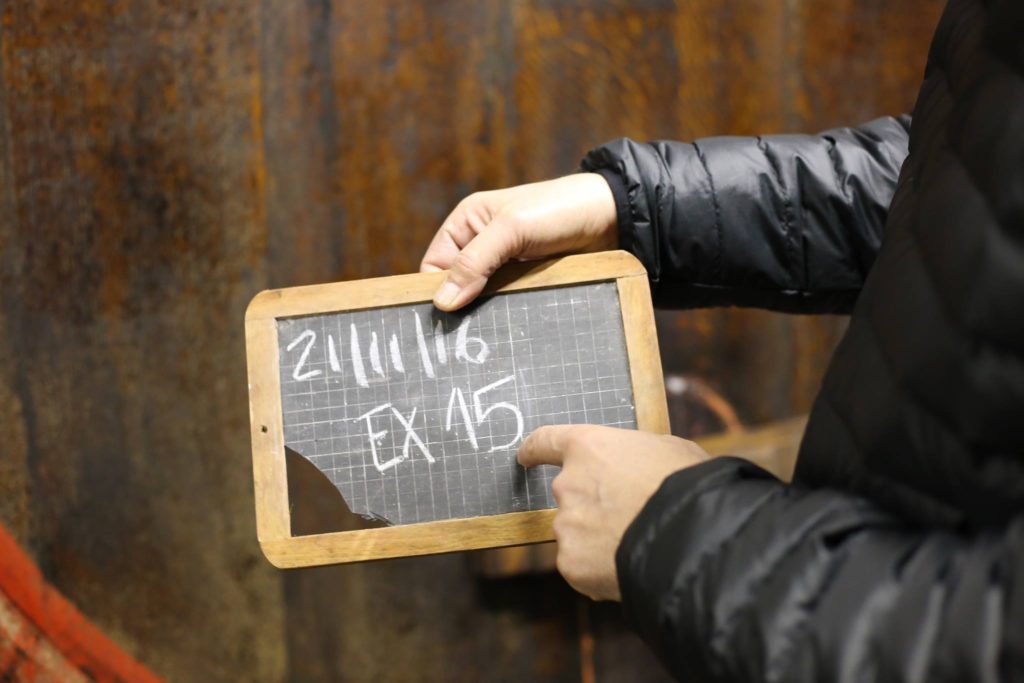
樽について
大きいサイズの樽(バレル)を10個と、小さいサイズの樽(カスク)を使用しています。大樽はたくさんの容量を扱うことができますが、熟成というよりはむしろ容器として樽を使っています。小さいバレルは2,000L、大きいもで5,700L、樹齢約50年のオークを使った伝統的な樽です。
どのタンクで熟成されたかを記入しています。
例えば、“ex 15”は、15番のタンクで熟成されたことを意味します。大切なことは、ボトリングするまでの工程をそれぞれのタンクごとに醸造することです。どのブドウがどのタンクに入っているかの足取りを必ず把握しています。
大樽の掃除は、樽の内部に入ります。樽の中は実はアルコールの香りはあまりなく、醸造タンク内の方が漂っています。樽の形状が空気の循環を促し、内部は心地よいです。私のように狭い場所が苦手な人間にとっても、包みこまれるような安心できる空間です。毎年行う清掃方法は、初めに熱湯をかけ、その蒸気で木材の表面の隙間を少し広げブラシをかけます。

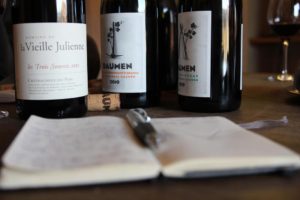
収穫時期や醸造期間をボードに記入し、一目で適正なタイミングと工程を確認できるようにしています。どんな躊躇も許されず、今、というタイミングの判断を即座に決める必要があります。同時に、詩人のような繊細さ、豊かな想像力と芸術的な側面も持ち合わせなくてはいけません。つまりは、両方の感覚をバランスよく備えておくのです。
全ては技術なのです。空気のようなワインを造る芸術家のような醸造家もいます。個人的には、私は土の香りがするワインが好みですが、この対比的な2つの要素の均衡を考えなくてはいけません。私たちは永久に探求し続けます。
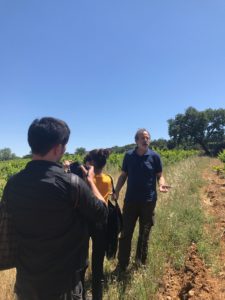
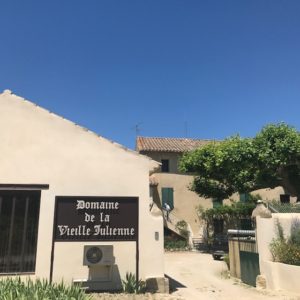
大切なことは?
良質な果実であるブドウ、そしてバランス。そのブドウが適度な糖度と酸味を持ち、そして野生の酵母を持つこと。
ワインとは必要要素が安定した形に融合したものが、ワインなのです。
ブドウ畑から全てが始まるのです。
SO2(亜硫酸塩:酸化防止剤)について
ワインがSO2に最初に触れるのは、樽の中です。2つの樽を清掃、乾燥、そして、硫黄燻蒸する際に起こります。硫黄燻蒸を十分に行わないと、細菌が繁殖し、揮発性の酸が発生し、その樽は使い物にならなくなります。その樽でできたワインは、ヴィネガーとして出荷するしかないのです。
私は、ワインを運搬するには、SO2は必要な物質だと考えています。一方で友人であり醸造家のマーセル・ラピエールの見解も理解できます。
SO2の使用に関しては、使用するかしないかというよりは、私たちが受け入れる準備ができているかだと思います。
ワイン1Lあたり40mg以下のSO2は、人体に影響がないと考えています。醸造時最大2mgを添加しますが、ビオディナミワインの二酸化硫黄含有規制値は、1Lあたり70mg以下です。(従来のワインの場合100mg以下)
含有量を最小限に抑えるのは技術です。例えば、樽内の初期段階で使用するSO2は、終盤で加えるものより安定しています。ということは、使用量は、最小限に抑えられるのです。総亜硫酸の量に対して、半分の遊離型亜硫酸が理想の含有比になります。例えば、総亜硫酸40mg/Lに対して、遊離型亜硫酸は20mg/Lを添加します。この比率は、安定したワインを造るのに最適な比率なのです。
酸化防止剤であるSO2は、量が多ければ体に害をおよぼします。特に、石油化学で発生したものは害が大きいので、私どもは、岩石から得られるSO2を使用していますが、石油化学系のものを使用するよう規制されています。これは、とてもおかしな話です。
SO2の使用を疑問に思うことは、とても大切なことですが、全く含有していないワインはないと思っています。有無に関する疑問は、醸造家の考えからかけ離れたところで議論されているように感じます。
ワインとは、全てバランスであり、自然からの恵みなのです。
土壌で切磋琢磨作業をしていれば、補酸や培養酵母は必要ありませんが、少量のSO2はワインを安定させるために必要になります。自然派ワインとは、一つの概念であり、醸造家の思いではないのです。しかし、どの考えも疎かにするわけにはいかないのも事実です。
2017年6月 ヴィエイユジュリアン訪問
AOCシャトーヌフ・デュ・パプ北端、なだらかな北向き斜面
土表面は草が覆い茂りその下の土は小石の混ざる土、赤味がかった土、さらさらとした砂など様々。ブドウは混栽

– Visit of the cellar-
We have a heating system under our tanks to maintain the concrete at the right temperature in order to lower it down as slow as possible at the time of fermentation.
At the beginning of the vinification process we start to air-condition the cellar very freshly to lower down the temperature, during the whole summer we keep it at 18,19°C.
Before to start harvesting we have them dropped at 15°C during one month, concrete temperature dropped at 15°C therefore we start vinications with very cold tanks .
One of the danger faced during the harvest is to have very high temperatures. 2016 was ok but some years we bring back grapes in the cellar with temperatures as 28, 29°C so it is a good thing to put grapes in a colder environment.
Our goal is to not directly intervene on the grapes neither at cold nor hot temperatures. We only intervene on the environment. At the end of the fermentation process we keep a temperature slightly warm to let the temperatures decrease much more slowly. And at first that’s exactly why we keep a cold atmosphere, in order that temperatures rise more reasonably. That’s my way to work rather then doing any intervention directly on the grapes.
The casks
We have only 10 barrels the rest are only casks. Barrels are allowing you to play with volume, we use more as a container rather than a maturing tool. It’s really to mature the volums . It’s more for press wine. We have only traditionnal oak barrels , the smaller are 20 hectoliter and the bigger are 57 hectoliter, the wood is around 50 years old. The indication ex15 means that this wine was aged in the tank number 15. A very important thing is that we work until bottling seprately on each vinification tank. I always have in mind which grapes were in the tank it helps me keeping track until the bottle . Cleaning the large casks is a very peculiar experience, you have to enter entirely inside, but you don’t smell alcohol as you can do in a vinification tank. The shape of the cask , the air circulation inside is such that you feel quite confortable, even for someone as me you is not a big fan of confine, small spaces. The atmosphere inside is very soft, enveloping. It’s cleaned with a brush every year. We spray first hot water and let the vapor dilate a bit the wood pores.
Les Trois Sources:
It is a cuvée blending. There are two parts, one is more early . It’s two casks blended during the bottling. 2016 bottling was end of february 2017. After the bottling we wait 4 months before to put them on the market.
For each vintage we keep 300/400 bottles. 2013 and 2014 were two difficult years and it was not easy to keep that number.
What’s important ?
To have a good fruit, a good grape, balance, containing the right quantity of sugar, acidity, natural yeast. It’s one of the rare transformed product which stay stable. The work is first in the vineyard.
Which type of glass would you recommend for your wines ?
Glasses of Saint Gobin. (the same craftman who made the Louvres pyramid).
For tasting we use Riddle glasses.
We have a board to keep updates visually, precisely and quickly of harvest and vinification periods. There is a balance. We need exactitude, we need to quickly decide that it’s this moment and not an other. And at the same time comes into play more senses, creativity, artistique side, experience, some poetry.
Overall you need technique. Some winemakers are real artist they make really aerial wines. I personnaly prefers tellurian wines, rooted. It’s a balance though to find between the two. We are in a perpetual research of balance.
Sulfites:
The first contact of the wine with So2 will be in the casks. Between two vintages we wash them, dry them, wicked them. If you don’t wick a cask a bacterial degradation will follow and you will find a volatile acidity damaging the cask to the point that it’ll become unusable. The wines will become proper vinegar. It’s a must do.
I personnaly think that So2 must be used if you want to transport the wines. I agree with the questioning , for example the work of my friend Marcel Lapierre, a pioneer in natural wine philosophy, it’s something important.
But rather than thinking not to put So2 at all the question is more which levels we are ready to accept. I believe that until 40mg/l of total So2 amount there is no effect for the human body, we don’t feel it. The maximum i will use is 2mg during the vinification process. In biodynamic the maximum is 70mg/l and in conventional 100mg/l.
It’s all about finding techniques to use it the less possible. The So2 you use in the casks at the beginning makes more stable the So2 used later. And you will need to add less. The ideal is to have the best ratio between total So2 and free So2. I reach the ratio of 1 for 2, so if we have 20mg/l free So2 we have 40mg/l total So2. It’s a good ratio. My objective is to make a stable wine.
So2 is a preservative so it’s not ideal for health to use it in big amount. Especially knowing that the ones geenrally used in wines comes from the petrochemistry. We use generally the So2 from quarries but nowadays we are forced to use petrochemical sulfites, natural ones being considered not edible. It’s a nonsense.
It’s a good thing to question the use of So2 but no So2 wines are, in my opinion, more something tending to militantism than a winemaker idea.
It’s all about balance. Again wine is a natural product, if you work well in the field you don’t need acidity or yeast but a low level of So2 helps to keep its stability.
Natural wine is beforehand a concept not really a winegrower idea. But again we should respect everyone vision. 

